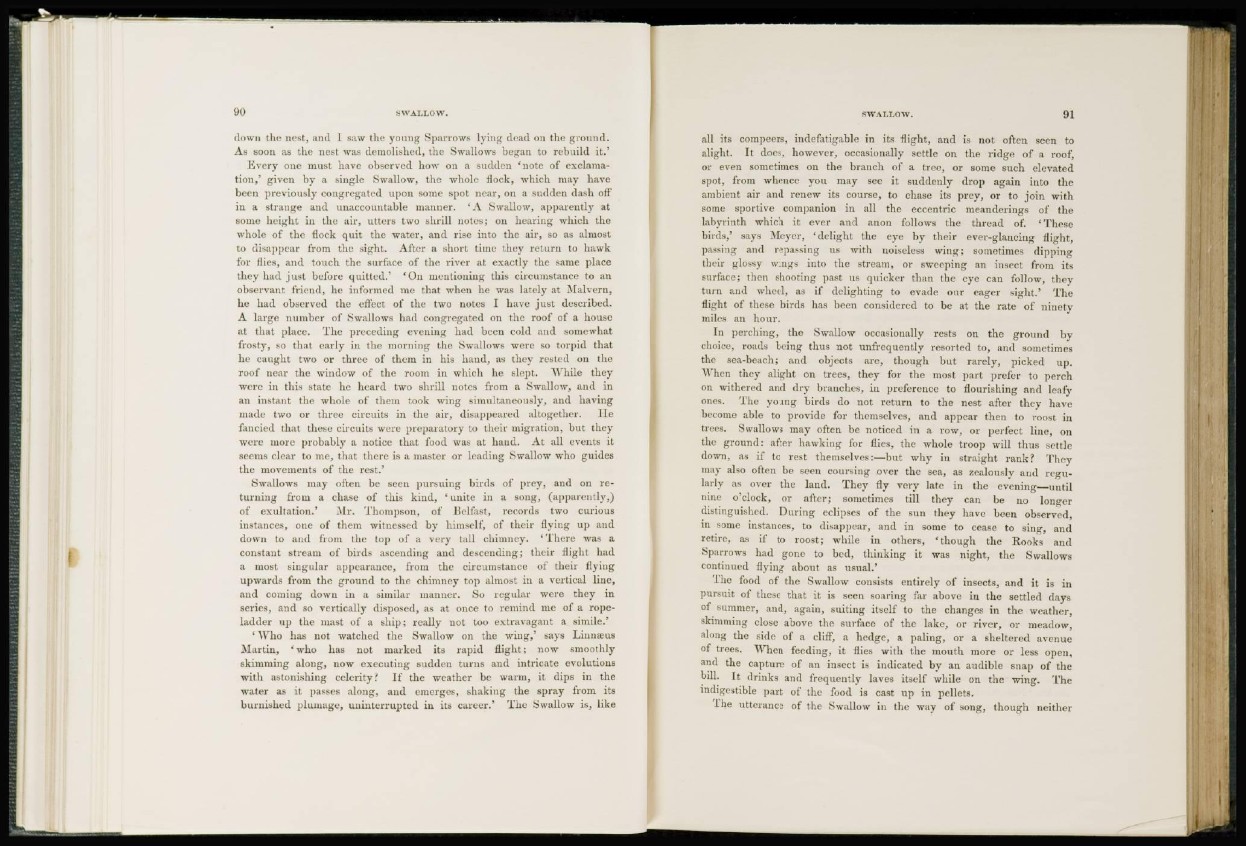
down the nest, and 1 saw the young Sparrows lying dead on the ground.
As soon as the nest was demolished, the Swallows began to rebuild it.'
Every one must have observed how on a sudden 'note of exclamation,'
given by a single Swallow, the whole flock, which may have
been previously congregated upon some spot near, on a sudden dash off
in a strange and unaccountable manner. 'A Swallow, apparently at
some height in the air, utters two shrill notes; on hearing which the
whole of the flock quit the water, and rise into the air, so as almost
to disappear from the sight. After a short time they return to hawk
for flies, and touch the surface of the river at exactly the same place
they had just before quitted.' 'On mentioning this circumstance to an
observant friend, he informed me that when he was lately at Malvern,
he had observed the effect of the two notes I have just described.
A large number of Swallows had congregated on the roof of a house
at that place. The preceding evening had been cold and somewhat
frosty, so that early in the morning the Swallows were so torpid that
he caught two or three of them in his hand, as they rested on the
roof near the window of the room in which he slept. While they
were in this state he heard two shrill notes from a Swallow, and in
an instant the whole of them took wing simultaneously, and having
made two or three circuits in the air, disappeared altogether. He
fancied that these circuits were preparatory to their migration, but they
were more probably a notice that food was at hand. At all events it
seems clear to me, that there is a master or leading Swallow who guides
the movements of the rest.'
Swallows may often be seen pursuing birds of prey, and on returning
from a chase of this kind, ' unite in a song, (apparently,)
of exultation.' .Mr. Thompson, of Belfast, records two curious
instances, one of them witnessed by himself, of their flying up and
down to and from the top of a very tall chimney. ' There was a
constant stream of birds ascending and descending; their flight had
a most singular appearance, from the circumstance of their flying
upwards from the ground to the chimney top almost in a vertical line,
and coming down in a similar manner. So regular were they in
series, and so vertically disposed, as at once to remind me of a ropeladder
up the mast of a ship; really not too extravagant a simile.'
'Who has not watched the Swallow on the wing,' says Liunseus
Martin, 'who has not marked its rapid flight; now smoothly
skimming along, now executing sudden turns and intricate evolutions
with astonishing celerity I If the weather be warm, it dips in the
water as it passes along, and emerges, shaking the spray from its
burnished plumage, uninterrupted in its career.' The Swallow is, like
all its compeers, indefatigable in its flight, and is not often seen to
alight. It does, however, occasionally settle on the ridge of a roof,
or even sometimes on the branch of a tree, or some such elevated
spot, from whence you may see it suddenly drop again into the
ambient air and renew its course, to chase its prey, or to join with
some sportive companion in all the eccentric meanderings of the
lahvrinth which it ever and anon follows the thread of. 'These
birds,* says Meyer, 'delight the eye by their ever-glancing flight,
passing and repassing us with noiseless wing; sometimes dipping
their glossy wings into the stream, or sweeping an insect from its
surface; then shooting past us quicker than the eye can follow, they
turn and wheel, as if delighting to evade our eager sight.' The
flight of these birds has been considered to be at the rate of ninety
miles an hour.
In perching, the Swallow occasionally rests on the ground by
choice, roads being thus not unfrequently resorted to, and sometimes
the sea-beach; and objects are, though but rarely, picked up.
When they alight on trees, they for the most part prefer to perch
on withered and dry branches, in preference to flourishing and leafy
ones. The young birds do not return to the nest after they have
become able to provide for themselves, and appear then to roost in
trees. Swallows may often be noticed in a row, or perfect line, on
the ground: after hawking for flies, the whole troop will thus settle
down, as if to rest themselves:—but why in straight rank ? They
may also often be seen coursing over the sea, as zealously and regularly
as over the land. They fly very late in the evening—until
nine o'clock, or after; sometimes till they can be no longer
distinguished. During eclipses of the sun they have been observed,
in some instances, to disappear, and in some to cease to sing, and
retire, as if to roost; while in others, ' though the Rooks and
Sparrows had gone to bed, thinking it was night, the Swallows
continued flying about as usual.'
The food of the Swallow consists entirely of insects, and it is in
pursuit of these that it is seen soaring far above in the settled days
of summer, and, again, suiting itself to the changes in the weather,
skimming close above the surface of the lake, or river, or meadow,
along the side of a cliff, a hedge, a paling, or a sheltered avenue
of trees. When feeding, it flies with the mouth more or less open,
and the capture of an insect is indicated by an audible snap of the
bill. It drinks and frequently laves itself while on the wing. The
indigestible part of the food is cast up in pellets.
The utterance of the Swallow in the way of song, though neither